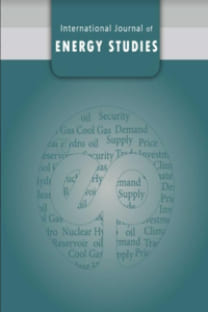Site selection of Antarctic Research Stations in aspect of required optimum hybrid renewable system capacity
Site selection of Antarctic Research Stations in aspect of required optimum hybrid renewable system capacity
Cold climate, Electricity production, Renewable system Optimization,
___
- [1] Yavaşoğlu H, Karaman H, Özsoy B, Bilgi S, Tutak B, Gengeç AG, Oktar Ö, Yirmibeşoğlu S. Site selection of the Turkish Antarctic Research station using Analytic Hierarchy Process. Polar Science 2019; 22: 100473.
- [2] Xiaoping P, Haiyan L, Xi Z. Selecting suitable sites for an Antarctic research station: a case for a new Chinese research station. Antarctic Science 2014; 26(5): 479–490.
- [3] Trubetskoy S. Antarktika nüfusu, 2019. Available: https://sashamaps.net/docs/maps/population-of-antarctica/.
- [4] Lonin S, Rios-Angulo WA, Coronado J. Swell Conditions at Potential Sites for the Colombian Antarctic Research Station. Sustainability 2022; 14(4): 2318.
- [5] Lucci JJ, Alegre M, Vigna L. Renewables in Antarctica: an assessment of progress to decarbonize the energy matrix of research facilities. Antarctic Science 2022; 34(5): 374-388.
- [6] Vigna L. Renewable Energy in Antarctic Research Facilities. 2022. Available: https://public.flourish.studio/visualisation/5888942/.
- [7] Boccaletti C, Felice PD, Santini E. Integration of renewable power systems in an Antarctic Research Station. Renewable Energy 2014; 62: 582-591.
- [8] Christo TM, Fardin JF, Simonetti DSL, Encarnação LF, Alvarez CE. Design and analysis of hybrid energy systems: The Brazilian Antarctic Station case. Renewable Energy 2016; 88: 236-246.
- [9] Dou Y, Zuo G, Chang X, ChenY. A Study of a Standalone Renewable Energy System of the Chinese Zhongshan Station in Antarctica. Applied Sciences 2019; 9: 1968.
- [10] Bockelmann F, Dreier AK, Zimmermann J, Peter M. Renewable energy in Antarctica - Photovoltaic for Neumayer Station III. Solar Energy Advances 2022; 2: 100026.
- [11] Crawley D, Lawrie L. Climate.OneBuilding.Org, 2022. Available: http://climate.onebuilding.org/default.html.
- [12] CW. CW 675 Wp, 2023. Available: https://cw-enerji.com/tr/urun/cw-enerji-675-wp-132pmbs-m12-hc-mb- gunes-paneli-1289.html.
- [13] SD Wind Energy. SD3, 2023. Available: https://sd-windenergy.com/small-wind-turbines/sd3-3kw-wind-turbine/.
- [14] Al-Ghussain L, Taylan O, Baker DK. An investigation of optimum PV and wind energy system capacities for alternate short and long-term energy storage sizing methodologies. International Journal of Energy Research 2019; 43(1): 204-218.
- [15] Tazay A. Techno-Economic Feasibility Analysis of a Hybrid Renewable Energy Supply Options for University Buildings in Saudi Arabia. Open Engineering 2021; 11(1): 39-55.
- [16] Li J, Wei W, Xiang J. A simple sizing algorithm for stand-alone PV/wind/battery hybrid microgrids. Energies 2012; 5(12): 5307-5323.
- [17] Belmili H, Haddadi M, Bacha S, Almi MF, Bendib B. Sizing stand-alone photovoltaic–wind hybrid system: Techno-economic analysis and optimization. Renewable and Sustainable Energy Reviews 2014; 30: 821-832.
- [18] Haidar AM, Fakhar A, Helwig A. Sustainable energy planning for cost minimization of autonomous hybrid microgrid using combined multi-objective optimization algorithm. Sustainable Cities and Society 2020; 62: 102391.
- [19] Kaabeche A, Ibtiouen R. Techno-economic optimization of hybrid photovoltaic/wind/diesel/battery generation in a stand-alone power system. Solar Energy 2014; 103: 171-182.
- [20] Jakhrani AQ, Rigit ARH, Othman AK, Samo SR, Kamboh SA. Estimation of carbon footprints from diesel generator emissions. International Conference on Green and Ubiquitous Technology, Bandung, Indonesia, 2012.
- [21] Tomov P. Multilayer Perceptron Fast Prototyping with Differential Evolution and Particle Swarm Optimization in LibreOffice Calc. Bulgarian Academy of Sciences Problems of Engineering Cybernetics and Robotics 2021; 75: 5-14.
- [22] MacEachern C, Yıldız I. Wind Energy, Comprehensive Energy Systems, Elsevier, 2018; 665-701.
- Yayın Aralığı: Yılda 4 Sayı
- Başlangıç: 2016
- Yayıncı: Türkiye Enerji Stratejileri ve Politikaları Araştırma Merkezi (TESPAM)
Effect of the various tritium breeding materials on the tritium breeding ratio in ARC fusion reactor
Transverse flux generator design for wind turbine at the rural areas
Grid connected photovoltaic system design an example application for İstanbul province
Taner DİNDAR, Ali Samet SARKIN, Vedat ESEN
Experimental and numerical investigation of different wing profiles
Murat ŞAHİN, Mehmet Arif SALTAN, Burak Berk BAŞKAYA
A detailed emission analysis between regional jet and narrow-body passenger aircraft
Seda TÖZÜM AKGÜL, İbrahim YILDIRAN, Turgut ERDEM, Nuray ATEŞ, Şehnaz Şule BEKAROĞLU
Evaluation of energy efficient building envelope alternatives for sustainable cities
